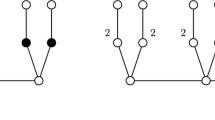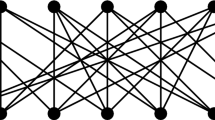Abstract
In this paper we continue the investigation of total domination in Cartesian products of graphs first studied in (Henning, M.A., Rall, D.F. in Graphs Comb. 21:63–69, 2005). A set S of vertices in a graph G is a total dominating set of G if every vertex in G is adjacent to some vertex in S. The maximum cardinality of a minimal total dominating set of G is the upper total domination number of G, denoted by Γ t (G). We prove that the product of the upper total domination numbers of any graphs G and H without isolated vertices is at most twice the upper total domination number of their Cartesian product; that is, Γ t (G)Γ t (H)≤2Γ t (G □ H).
Similar content being viewed by others
References
Archdeacon D, Ellis-Monaghan J, Fischer D, Froncek D, Lam PCB, Seager S, Wei B, Yuster R (2004) Some remarks on domination. J Graph Theory 46:207–210
Brešar B (2005) Vizing-like conjecture for the upper domination of Cartesian products of graphs—the proof. Electron J Comb 12:N12
Clark WE, Suen S (2000) An inequality related to Vizing’s conjecture. Electron J Comb 7:N4
Cockayne EJ, Dawes RM, Hedetniemi ST (1980) Total domination in graphs. Networks 10:211–219
Favaron O, Henning MA (2003) Upper total domination in claw-free graphs. J Graph Theory 44:148–158
Hartnell B, Rall DF (1998) Domination in Cartesian products: Vizing’s conjecture. In: Haynes TW, Hedetniemi ST, Slater PJ (eds) Domination in graphs: advanced topics. Dekker, New York, pp 163–189
Haynes TW, Hedetniemi ST, Slater PJ (eds) (1998a) Fundamentals of domination in graphs. Dekker, New York
Haynes TW, Hedetniemi ST, Slater PJ (eds) (1998b) Domination in graphs: advanced topics. Dekker, New York
Henning MA (2000) Graphs with large total domination number. J Graph Theory 35(1):21–45
Henning MA, Rall DF (2005) On the total domination number of Cartesian products of graph. Graphs Comb 21:63–69
Imrich W, Klavžar S (2000) Product graphs: structure and recognition. Wiley, New York
Nowakowski RJ, Rall DF (1996) Associative graph products and their independence, domination and coloring numbers. Discuss Math Graph Theory 16:363–366
Vizing VG (1968) Some unsolved problems in graph theory. Usp Mat Nauk 23(144):117–134
Author information
Authors and Affiliations
Corresponding author
Additional information
Research of M.A. Henning supported in part by the South African National Research Foundation and the University of KwaZulu-Natal.
Rights and permissions
About this article
Cite this article
Dorbec, P., Henning, M.A. & Rall, D.F. On the upper total domination number of Cartesian products of graphs. J Comb Optim 16, 68–80 (2008). https://doi.org/10.1007/s10878-007-9099-8
Published:
Issue Date:
DOI: https://doi.org/10.1007/s10878-007-9099-8




